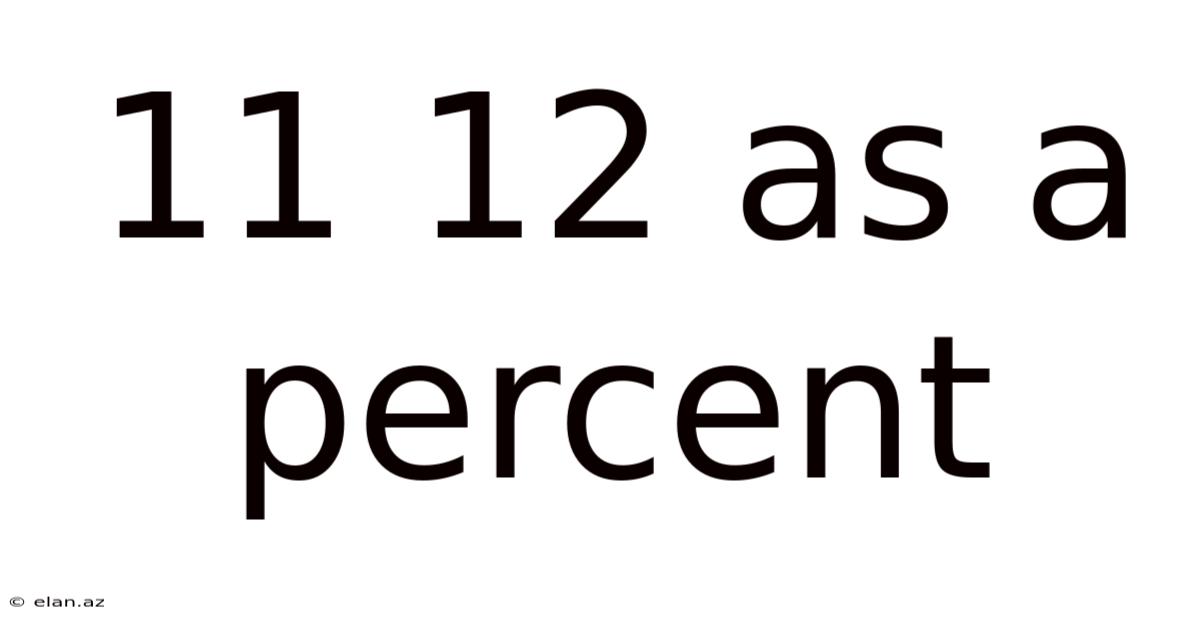11 12 As A Percent
elan
Sep 16, 2025 · 5 min read

Table of Contents
11/12 as a Percent: A Comprehensive Guide to Understanding Fractions, Decimals, and Percentages
Understanding the relationship between fractions, decimals, and percentages is a fundamental skill in mathematics and has wide-ranging applications in everyday life. This comprehensive guide will delve into how to convert the fraction 11/12 into a percentage, exploring the underlying concepts and providing practical examples. We'll also address common questions and misconceptions surrounding percentage calculations. This guide aims to equip you with a solid understanding of this crucial mathematical concept.
Introduction: The Basics of Fractions, Decimals, and Percentages
Before we dive into converting 11/12 into a percentage, let's briefly review the basics of these three interconnected concepts:
-
Fractions: A fraction represents a part of a whole. It's expressed as a ratio of two numbers, the numerator (top number) and the denominator (bottom number). For example, 11/12 means 11 parts out of a total of 12 parts.
-
Decimals: A decimal is another way to represent a part of a whole. It uses a base-10 system, with a decimal point separating the whole number part from the fractional part. For example, 0.5 is equivalent to 1/2.
-
Percentages: A percentage is a way of expressing a number as a fraction of 100. The symbol "%" is used to denote a percentage. For example, 50% means 50 out of 100, which is equivalent to 1/2 or 0.5.
Converting 11/12 to a Percentage: Step-by-Step Guide
There are two primary methods for converting the fraction 11/12 to a percentage:
Method 1: Converting the Fraction to a Decimal First
This method involves two steps:
-
Convert the fraction to a decimal: To do this, divide the numerator (11) by the denominator (12).
11 ÷ 12 = 0.916666... (the 6 repeats infinitely)
-
Convert the decimal to a percentage: Multiply the decimal by 100 and add the percent symbol (%).
0.916666... × 100 ≈ 91.67%
We round the decimal to two decimal places for practical purposes. Therefore, 11/12 is approximately 91.67%.
Method 2: Direct Conversion using Proportion
This method uses the concept of proportion:
-
Set up a proportion: We know that a percentage is a fraction out of 100. So, we can set up the following proportion:
11/12 = x/100
Where 'x' represents the percentage we want to find.
-
Solve for x: To solve for x, we can cross-multiply:
12x = 1100
x = 1100/12
x ≈ 91.67
Therefore, 11/12 is approximately 91.67%.
Understanding the Result: What does 91.67% Mean?
The result, 91.67%, signifies that 11/12 represents approximately 91.67 parts out of every 100 parts. It's a way of expressing the fraction in a more readily understandable and comparable format, particularly when dealing with proportions and ratios in various contexts.
Practical Applications of Percentage Conversions
Converting fractions to percentages has numerous real-world applications:
- Finance: Calculating interest rates, discounts, profit margins, and tax rates.
- Science: Expressing experimental results, statistical data, and probability.
- Everyday Life: Understanding sales, tips, and comparing prices.
Common Mistakes and Misconceptions
Several common mistakes can occur when converting fractions to percentages:
- Incorrect order of operations: Remember to divide the numerator by the denominator before multiplying by 100.
- Rounding errors: Rounding too early in the calculation can lead to significant inaccuracies in the final result. It's best to round only at the very end.
- Confusing fractions with decimals: Remember that decimals are a different representation of a fraction; converting between them requires specific mathematical steps.
- Forgetting the percentage symbol: Always remember to include the "%" symbol to indicate that the value is a percentage.
Frequently Asked Questions (FAQ)
Q: Is 91.67% the exact value of 11/12 as a percentage?
A: No, 91.67% is an approximation. The decimal representation of 11/12 is a repeating decimal (0.916666...), so any percentage representation will be an approximation unless expressed as a repeating decimal percentage (91.666...%).
Q: How can I convert a percentage back to a fraction?
A: To convert a percentage back to a fraction, divide the percentage by 100 and simplify the resulting fraction. For example, to convert 91.67% back to a fraction:
91.67/100 ≈ 11/12 (This is an approximation due to rounding.)
Q: What if the fraction has a larger numerator than denominator (an improper fraction)?
A: If the fraction is improper (numerator > denominator), the resulting percentage will be greater than 100%. This simply indicates a value larger than the whole.
Advanced Concepts: Working with Percentages in Complex Scenarios
While converting 11/12 to a percentage is a relatively straightforward process, more complex scenarios might involve:
- Percentage increase or decrease: Calculating the percentage change between two values.
- Compound percentages: Applying percentages repeatedly, such as compound interest calculations.
- Percentage points: Understanding the difference between percentage change and percentage points.
Conclusion: Mastering Percentage Conversions
Understanding how to convert fractions to percentages is an essential skill with far-reaching applications. By mastering this concept, you can confidently tackle various mathematical problems and real-world situations involving ratios, proportions, and comparisons. Remember to always pay attention to detail, follow the steps carefully, and utilize appropriate rounding techniques to ensure accuracy. The ability to confidently work with percentages is a valuable asset, whether in academic pursuits, professional endeavors, or everyday life. Continuous practice and exploration of related concepts will further solidify your understanding and improve your proficiency in this critical area of mathematics.
Latest Posts
Latest Posts
-
P C O Full Form
Sep 16, 2025
-
Letters Of The Alphabet Images
Sep 16, 2025
-
Arrangement Of Particles In Solid
Sep 16, 2025
-
Rotational Symmetry Of Order 4
Sep 16, 2025
-
Is Brazil Larger Than Australia
Sep 16, 2025
Related Post
Thank you for visiting our website which covers about 11 12 As A Percent . We hope the information provided has been useful to you. Feel free to contact us if you have any questions or need further assistance. See you next time and don't miss to bookmark.